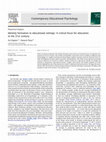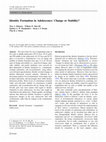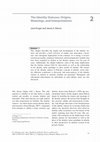Identity Formation by Moishe Mund
Teaching in the affective domain is required to facilitate development in the values, ethics, aes... more Teaching in the affective domain is required to facilitate development in the values, ethics, aesthetics, and feelings of social work students. It is arguably the most complicated type of teaching as it integrates cognition, behavior, and feelings. This paper presents an overview of affective learning as well as a pedagogical taxonomy for use in designing and delivering instruction in the affective domain. A sample lesson plan used to teach social justice and strategies for evaluating affective learning are also reviewed.
Purpose -The purpose of this paper is to interpret aspects of education for sustainability in rel... more Purpose -The purpose of this paper is to interpret aspects of education for sustainability in relation to educational theories of the affective domain (values, attitudes and behaviours) and suggest how the use of these theories, and relevant experience, in other educational areas could benefit education for sustainability. Design/methodology/approach -An analysis based on a literature review of relevant educational endeavours in affective learning.
academic year, I made several presentations related to affective learning, a topic familiar to me... more academic year, I made several presentations related to affective learning, a topic familiar to me because of my training as a psychologist ). This manuscript expands upon those presentations in the hope that faculty will become increasingly familiar with the purposes and value of affective learning in higher education. As used throughout this paper, affective learning refers to learning that relates to students' interests, attitudes, and motivations. It is my hope that this paper will demonstrate the utility of affective learning in course and program design and will stimulate the application by faculty members of affective learning principles in developing new General Education courses and programs.
Teaching in the affective domain is required to facilitate development in the values, ethics, aes... more Teaching in the affective domain is required to facilitate development in the values, ethics, aesthetics, and feelings of social work students. It is arguably the most complicated type of teaching as it integrates cognition, behavior, and feelings. This paper presents an overview of affective learning as well as a pedagogical taxonomy for use in designing and delivering instruction in the affective domain. A sample lesson plan used to teach social justice and strategies for evaluating affective learning are also reviewed.
Introduction. -Identity styles , identity dimensions and statuses , and identity functions repres... more Introduction. -Identity styles , identity dimensions and statuses , and identity functions represent important identity conceptualizations. However, the interrelationships among these constructs are not well understood.
Appeared in: Schwartz, S. J., Luyckx, K., & Vignoles, V. L. (Eds.; 2011). Handbook of identity th... more Appeared in: Schwartz, S. J., Luyckx, K., & Vignoles, V. L. (Eds.; 2011). Handbook of identity theory and research: Structure and processes. New York: Springer. (pp. 77-98) 1
This article reviews contemporary issues in the study of self and identity and introduces the spe... more This article reviews contemporary issues in the study of self and identity and introduces the special issue. Particularly highlighted are the need to integrate the various currents in self and identity, the need to study the role of context in the development of self and identity, research on self and identity in ethnic minority and international populations, and studies of national identity. The article concludes with recommendations for future research on self and identity.

This chapter examines identity formation in terms of a social-cognitive model. Identity is concep... more This chapter examines identity formation in terms of a social-cognitive model. Identity is conceptualized as a cognitive structure or self-theory, which provides a personal frame of reference for interpreting self-relevant information, solving problems, and making decisions. Identity is also viewed as a process that governs and regulates the social-cognitive strategies used to construct, maintain, and/or reconstruct a sense of personal identity. Three different identity-processing orientations or styles are explicated: Informational, normative, and diffuse-avoidant. Individuals with an informational processing style are skeptical of their own self-views and they intentionally seek out, process, and utilize identity-relevant information to personally resolve identity conflicts. In contrast, individuals with a normative processing style more automatically adopt a collective sense of identity by internalizing the standards and prescriptions of significant others and referent groups. Those with a diffuse-avoidant processing style are reluctant to confront and face up to identity conflicts; they procrastinate and delay as long as possible. Their actions tend to be influenced more by immediate situational rewards and demands than personally informed decisions or normative standards. Empirical evidence from several lines of research on identity-processing style is reviewed including linkages between identity style and a number of identity and cognitive processes; developmental changes in identity styles; and factors that may contribute to individual differences in identity styles such as gender, culture, parental processes, and personality traits. The role that identity-processing styles may play in effective and ineffective self-regulation and in maintaining a coherent sense of self-continuity is considered.

The present study was aimed at examining one relatively neglected part of the identity formation ... more The present study was aimed at examining one relatively neglected part of the identity formation process: the short-term dynamics of identity formation. The short-term dynamics were assessed by examining (a) the day-to-day course of 2 key dimensions of identity formation (i.e., commitment and reconsideration) and (b) the impact of fluctuations in commitment and reconsideration on subsequent levels of these 2 dimensions. Longitudinal data on 580 early adolescents (54.8% boys, 45.2% girls) were used to test these assertions. The authors found evidence for a commitment-reconsideration dynamic that operated on a day-to-day basis. Furthermore, the findings confirmed E. H. assertion that identity reflects a sense of sameness and continuity as a more stable identity (reflected by little day-to-day fluctuations) was predictive of higher levels of commitment and lower levels of reconsideration. Taken together, the present study underscores the importance of the short-term dynamics of identity formation.

There is growing recognition that identity formation must become an important focus in education.... more There is growing recognition that identity formation must become an important focus in education. Particularly in the 21st century, when modes of knowledge construction and accessibility to different types of knowledge are rapidly increasing and diversifying, academic learning cannot be divorced from students' development of values, goals, social roles, and worldviews. The articles in this special issue present a diverse collection of research on students' identity formation in educational settings. Yet, despite the diversity in perspectives, educational contexts, samples, and research and analytic methods, all of the articles highlight the role of the educational context in identity formation processes. We begin this introduction with a brief review of the increasing attention to identity formation in education. We follow with synopses of each of the articles in this special issue.

The aim of this five-wave longitudinal study of 923 early to middle adolescents (50.7% boys; 49.3... more The aim of this five-wave longitudinal study of 923 early to middle adolescents (50.7% boys; 49.3% girls) and 390 middle to late adolescents (43.3% boys and 56.7% girls) is to provide a comprehensive view on change and stability in identity formation from ages 12 to 20. Several types of change and stability (i.e., mean-level change, rankorder stability, and profile similarity) were assessed for three dimensions of identity formation (i.e., commitment, in-depth exploration, and reconsideration), using adolescent self-report questionnaires. Results revealed changes in identity dimensions towards maturity, indicated by a decreasing tendency for reconsideration, increasingly more in-depth exploration, and increasingly more stable identity dimension profiles. Mean levels of commitment remained stable, and rank-order stability of commitment, in-depth exploration, and reconsideration did not change with age. Overall, girls were more mature with regard to identity formation in early adolescence, but boys had caught up with them by late adolescence. Taken together, our findings indicate that adolescent identity formation is guided by progressive changes in the way adolescents deal with commitments, rather than by changes in the commitments themselves.

This chapter describes the origins and development of the identity statuses and provides a brief ... more This chapter describes the origins and development of the identity statuses and provides a brief overview of studies into antecedent, concurrent, and consequent implications of the construct. In so doing, it reviews selected personality, relational, behavioral, and developmental variables that have been examined in relation to the identity statuses over the past 45 years. Additionally, the chapter addresses some of the many implications that the identity statuses hold for intervention as well as the relationship of the identity status paradigm to other models of identity. The rootedness of the identity statuses in Erikson's concept of identity versus identity diffusion (confusion) is discussed, and meta-analyses of the identity statuses in relation to selected variables are presented. Therapeutic and educational interventions for individuals in each identity status are also discussed.

Those aspects of Erikson's theory of psychosocial development concerning the formation of a sense... more Those aspects of Erikson's theory of psychosocial development concerning the formation of a sense of personal identity are examined in light of research evidence. When the Stage 5 component is considered as a bipolar dimension, the expectation is that the transition from adolescence to adulthood involves a progressive strengthening in the sense of identity. When the identity construct is expanded to include the processes by which an identity is formed, it is hypothesized that over time there will be progressive developmental shifts in identity status, that is, from the identity diffusion status into either the foreclosure or moratorium status, from the foreclosure into the moratorium status, and from the moratorium into the identity achievement status. The circumstances associated with progressive shifts, regressive changes, and reentry into an identity crisis are discussed. The review of the literature focuses on questions of the direction and timing of identity development, sex differences in development, and the identification of antecedent conditions relating to the choice of developmental pathways.
Adolescence is among the most confusing periods in the lifespan, largely because it is when we st... more Adolescence is among the most confusing periods in the lifespan, largely because it is when we start to doubt whatever our parents taught us while we struggle with finding something new to hold onto and guide us through life. In other words, a process known as identity formation starts in adolescence.











Uploads
Identity Formation by Moishe Mund